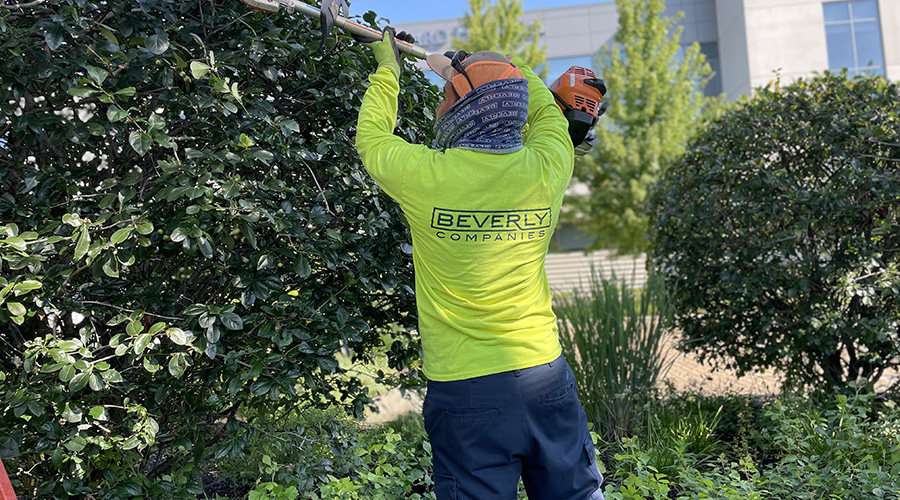Grounds Management Comes of Age
As more organizations recognize the impact of landscapes on facilities, the role of managers as planners and players expands
The role of grounds managers in institutional and commercial facilities has changed as much in recent years as the landscapes their departments maintain. Traditionally, grounds managers had been associated primarily with such tasks as mowing, fertilizing, aerating and, in northern climates, plowing.
While these duties remain high priorities, many managers’ roles have evolved and expanded. The change has come as those in other areas of organizations have come to appreciate the role that grounds play, not just in shaping the image of an organization and its facilities, but in contributing to the organization’s bottom line.
Shifting Thinking
Grounds managers for decades have faced an issue that is all too familiar to their peers in charge of facilities maintenance. They inherit renovation or new construction projects that have been designed poorly, feature incompatible elements and are nightmares to maintain. The results were predictable and frustrating.
“When there was new construction, the grounds crew would follow right behind and do it right,” says Ellen Newell, CGM, assistant director of grounds services with Arizona State University. And doing it right meant spending time and money to tweak elements of the landscape to prevent even bigger problems down the road.
“The landscape architect might want the trees close to the building,” says Kevin O’Donnell, director of Grounds at Villanova University. “But if you have to inherit that design, you know you’re going to have to prune those trees. At maturity, they’re going to be too big.”
These days, however, the stakes are too high when it comes to landscape planning and design. With growing pressure to control costs, few organizations can afford to spend money fixing problems that could have been avoided. And as the cost of water rises in all areas of the country, organizations can’t afford to waste the precious commodity because those planning and executing the landscape changes don’t make smart decisions.
“Contractors know plants, but they don’t know plant maintenance,” Newell says.
Changing Thinking
More often these days, grounds managers are getting involved in the landscape planning process much earlier. The change has occurred for a number of reasons.
First, many managers themselves have changed.
“People in our field now are more educated,” Newell says, referring to expanded training, education and certification opportunities from a range of sources on issues such as plant selection, irrigation planning, environmental impact, landscape design, project management and staff development. By pursuing expertise beyond traditional areas of involvement, managers have set themselves up as professionals and experts on a range of issues.
Second, the environment within many organizations has changed. Now, there is broader recognition that all areas of facilities — including grounds — are interconnected. Top management in many cases also has rethought its views of grounds managers.
“It helps that we’ve had some progressive directors and vice presidents,” Newell says. Such support is recognition that managers can bring something essential to the process.
“We bring value,” O’Donnell says. Many managers understand the long-term needs of a landscape’s elements, from turf and trees to site furniture and paved areas. Understanding how these components work together — or don’t — can be essential in producing a design that is both aesthetically pleasing and maintainable.
O’Donnell says his department has long been involved in broader issues, such as landscape planning and design.
The role “really hasn’t changed much,” he says. “We still make an effort to give our input before the designs are done. We try to provide our expertise to architects and share with them what works and what doesn’t work.”
The motivation is financial, as well as practical.
“If the design is proper from the beginning, it will save money in the long run,” O’Donnell says. For example, knowing how vegetation can affect sunlight entering buildings, managers can ensure the proper placement of plants to minimize pruning and to keep building interiors cooler.
The goal is “the right plant in the right place,” O’Donnell says. Managers’ experience and knowledge also can help planners decide when it’s appropriate to bolt down site furniture and when it’s not — an issue that greatly affects both maintainability and aesthetics.
Making an Impact
For managers looking to broaden their involvement in planning processes, clear communication with other team members is essential, as is preparation.
“You have to be ready to justify what you recommend if want to be part of the process,” O’Donnell says.
Newell suggests using pictures to help others understand what their decisions might mean for the future. For example, mature plants are larger and so will require more space than younger plants, so planning for that future need before planting will help the organization avoid replanting or pruning later.
Managers can demonstrate their value to the process most clearly by identifying potential trouble spots in landscape designs or existing landscapes and, more importantly, quantifying the problem.
“If you have an area that needs a lot of maintenance, show the cost to maintain that area early in the process.” O’Donnell says.
Driving Forces
The continuing rise of sustainability as an issue that affects all areas of facilities operations is among the leading issue managers can focus on, especially as it relates to landscapes.
“Sustainability has been kind of a buzz word, but it’s going to be the status quo,” Newell says. From selecting plants that are compatible with one another and offer long-term performance to ensuring plants complement — and even benefit — the facilities around them, most decisions managers make seem likely to include a discussion of sustainability.
Managers nationwide also will be challenged to make decisions that save water.
“We’re constantly thinking about it,” Newell says, adding that the university’s arid environment makes some decisions even tougher. For example, trying to minimize the use of turf and save water can have the unintended consequence of creating dust problems, which can create a new set of problems for both facilities and occupants.
While such issues require discussions among a range of players, they also offer grounds managers unique opportunities to put their experience and knowledge to work to deliver long-term benefits.
Related Topics:











